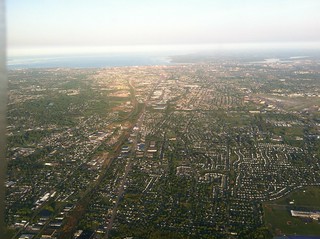[From the Vault] Regionalism: Time to Party Like it’s 1999
 I’ve heard it said that Buffalo is where good ideas go to die. I don’t think of it like that.
I’ve heard it said that Buffalo is where good ideas go to die. I don’t think of it like that.
Buffalo is where good ideas are made to inhale chloroform, dragged around to the back of the abandoned house, and murdered by status-quo driven self-interest.
Buffalo in 2011 (and 2012) is besotted with the same problems, the same issues, the same concerns, and – strikingly – the same debates it had a decade ago. Save one.
Regionalism.
Regionalism was murdered in 2005 after being debilitated by people who have an interest in maintaining the status quo, and then unintentionally killed by a politically beleaguered Joel Giambra; it was manslaughter. After all, during the last few years of his 16th floor Rath Building tenancy, Joel Giambra was political poison. If he was for pink bunny rabbits and sun-shiny days, polls would show that 20% of WNYers agreed with him, while 70% hated bunnies and sunshine, and a further 10% didn’t know.
But as wrong as Joel Giambra was about a lot of things, he was right about one – that western New York needed to seriously consider the implementation of regional, metropolitan government. The champion of this idea was Kevin Gaughan.
Gaughan recognized that regionalism – a concept whose entry in the regional socio-economic-political discussion began through a forum held in 1997 at the Chautauqua Institution – was a non-starter due to its support from, and association with the toxic Giambra. He turned his attention to another crusade – the “Cost“, which studied and determined that we ought to remedy a symptom of too many governments in WNY – i.e., too many politicians and appointees – and begin eliminating villages and downsizing town boards and other legislatures. That has been met with some success, more failure, and bypasses the disease itself.
Yet those familiar with the internet’s Way Back Machine can still access Gaughan’s arguments for regional metropolitan government.
One of the opinions I’m most known for is the idea that county government ought to be abolished. It was done in 1997 in Massachusetts, which recognized that county government largely adds no value to the work already done by cities, towns, villages, and – most importantly – the state.
We have so many redundant and needless governments in western New York that the regional is factionalized and fragmented. The Balkanization of western New York helps ensure that there is no unified plan – with a set vision, and a series of distinct goals – for moving a region into a 21st century reality.
We rely on the Sabres and the Bills to keep convincing ourselves that this is a major league city. It isn’t. Our infrastructure planning assumed that the City of Buffalo and Erie County would grow to a population of over 2 million people. It hasn’t; it’s shrunken. People clamor for change, yet moan about its actual implementation. As if by abolishing a village government you abolish the village itself and displace its people.
We are the ultimate hoarders; hoarders of pointless governmental entities that add no value to the civic equation. Why? Could it be as simple as my hypothesis – that there are too many people dependent on the maintenance of the status quo to permit change to be implemented?
It’s time for us, the people of Erie County and western New York, to start talking again about looking forward. The governmental number and structure of the 50s needs to change, or this region will continue to decline. The age of industry has given way to the age of knowledge and information.
The city of Toronto, Ontario is a municipal entity comprising over 2 million people. It has a directly elected mayor and a unicameral legislature made up of 44 councilmembers representing a geographical constituency. In 1998, Toronto and six surrounding municipalities joined, making up the amalgamated Metro Toronto. Buffalo also has a changed demographic reality, one that could do with some radical change. You mean to tell me that 45 elected officials to handle a population of 900,000 isn’t doable? Western New York has 45 separate and distinct governments, comprised of well over 300 elected officials.
This is the first in a series, and it’s my hope that we can re-spark this discussion and come up with ways to implement and design this new reality for western New York. I sincerely think that by making this switch to metropolitan government is the best chance for lurching us out of a 50s growth & infrastructure mentality that has been an anachronism for decades. This is an idea that will be fought tooth & nail by those who benefit from our stagnated status quo, but some of their points will be valid and need to be addressed. I hope to conclude with an action plan that will enable people to lobby, advocate, agitate, and cajole for this idea.
Downsize? Let’s downsize from 45 to 1.
Sometimes, old forgotten ideas are worth reviving. Let’s do that.
The foregoing article was first published on March 8, 2011. Unfortunately, it didn’t really become a “series”, and that’s my own fault. Maybe by re-publishing it here, thanks to the archives of my old 2006 – 2011 posts that is now back online, I’ll remind myself further to pursue this line of thought and debate.




